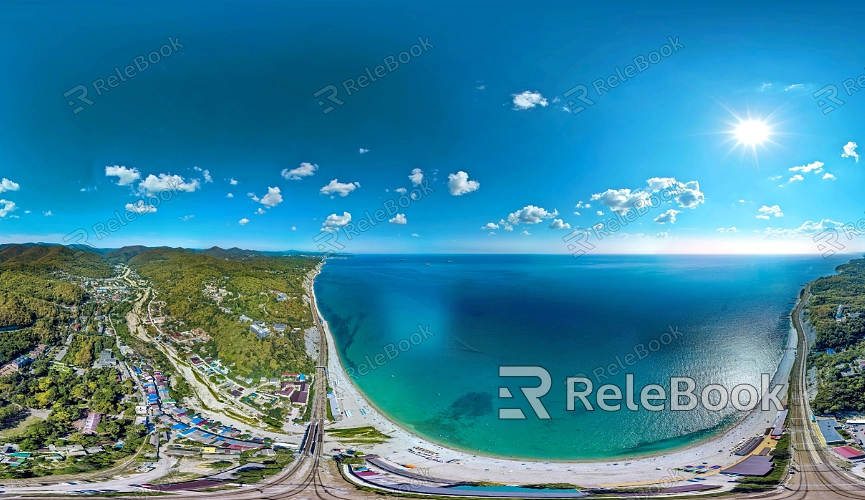Are HDR and 4K the Same Thing
In 3D rendering, the right textures significantly impact the realism and lighting effects of objects, especially in architectural and character scene renderings, directly influencing the viewer's visual experience. A common question that arises when dealing with various texture formats is: "Are HDR textures the same as 4K textures?" While both HDR and 4K textures can enhance image quality, their roles and characteristics are quite different. This article will explore the distinctions between HDR and 4K textures to help designers make the best choice for their projects.

1. Basic Concepts of HDR and 4K Textures
Understanding HDR Textures
HDR (High Dynamic Range) textures are image formats that can store more extensive lighting information. These textures capture the brightest and darkest parts of a scene, allowing for more dynamic brightness and color levels during rendering. HDR textures are often used in environment lighting (like skyboxes) and reflection maps to enhance the realism and detail of a scene.
Understanding 4K Textures
4K textures refer to image textures with a resolution of 4096x4096 pixels. Compared to the more common 2K (2048x2048 pixels) or 1K (1024x1024 pixels) textures, 4K textures provide greater detail and higher clarity. These high-resolution textures are typically used on model surfaces where fine details need to be displayed, such as skin in character models, building facades, or product prototypes.
2. Differences in Functionality Between HDR and 4K Textures
The Role of HDR Textures
HDR textures primarily enhance the lighting effects within a scene. Because they can record a wider range of brightness, HDR textures allow light sources to appear more realistic in renderings. For example, using an HDR texture as an environmental light source in interior renderings can create soft shadows from light streaming through windows, enriching the scene's overall ambiance.
The Role of 4K Textures
4K textures focus on adding detail and clarity to the surface of models. These high-resolution textures reveal finer surface details when viewed up close, such as tiny cracks, skin pores, or the bumps on an object's surface. Thus, 4K textures are particularly important in projects that require high-quality model surfaces.
3. Application Scenarios for HDR and 4K Textures
Where HDR Textures Shine
HDR textures are widely used in scenes that demand high-quality lighting and reflection effects. For instance, in car renderings, HDR textures can simulate the reflection of the surrounding environment on the car's body, making the rendering closely resemble a real-life photo. Similarly, in architectural visualization, HDR textures are often applied to skyboxes to provide natural daylight or nighttime effects. If you find searching for high-quality HDR images too complex or time-consuming, or if you're unsure where to start, consider visiting Relebook. You can easily download high-quality HDR images from https://textures.relebook.com/ to enhance your project's outcome.
Where 4K Textures Excel
4K textures are more commonly applied to model surfaces that need to display high-resolution details. For example, in character modeling, 4K textures can be used for skin, clothing, and accessories to maintain clarity even in close-up shots. In product design renderings, 4K textures help convey the material and surface details of a product, allowing viewers to better appreciate the product's texture and craftsmanship.

4. Pros and Cons of HDR and 4K Textures
Advantages and Disadvantages of HDR Textures
The main advantage of HDR textures lies in their ability to provide rich lighting information, enhancing the realism of rendered scenes. However, because HDR textures store a large amount of information, their file sizes are usually substantial, which can increase the computational load during rendering. Additionally, different rendering engines may have varying levels of support for HDR textures, requiring designers to adjust parameters according to specific situations.
Advantages and Disadvantages of 4K Textures
The key advantage of 4K textures is their high resolution, which offers exceptional detail, making them ideal for displaying finely detailed model surfaces. However, 4K textures also take up significant storage space and demand more from hardware during rendering. Using many 4K textures in a scene may lead to high memory usage, potentially affecting rendering speed and performance.
5. Combining HDR and 4K Textures
The Effect of Using HDR and 4K Textures Together
In some advanced rendering projects, HDR and 4K textures can be combined to enhance both lighting effects and surface detail. For instance, in architectural visualization, you might use HDR textures to manage environmental lighting while applying 4K textures to depict the textures and materials of building surfaces. This combination can achieve high realism while showcasing more intricate details.
Choosing the Right Textures for Your Project
Although HDR and 4K textures can be used together, not all projects require this combination. Designers should choose based on the project's needs and available hardware resources. For example, in a project focused on lighting effects, HDR textures might be more critical; in a project requiring high-resolution detail, 4K textures could be more essential.
6. Future Trends for HDR and 4K Textures
The Future of HDR Textures
As rendering technology continues to advance, the use of HDR textures will likely become more widespread. Particularly in real-time rendering and virtual reality (VR), HDR textures can offer more realistic lighting effects, enhancing immersion and interaction.
The Future of 4K Textures
4K textures will become increasingly common as display technology improves. In the future, with the emergence of 8K or even higher-resolution displays, designers may need to create even higher-resolution textures to meet more refined visual demands. Therefore, mastering and optimizing the use of 4K textures will be an essential skill for designers in the future.
Through this analysis, 3D modeling and rendering designers can better understand the differences between HDR and 4K textures. These are not interchangeable technologies but have distinct application scenarios and advantages. By wisely choosing and combining HDR and 4K textures in your projects, you can achieve higher quality rendering results. For more high-quality HDR and 4K texture resources, consider visiting Relebook. With its extensive selection, Relebook can help you effortlessly enhance your rendering projects, making your work truly stand out.

